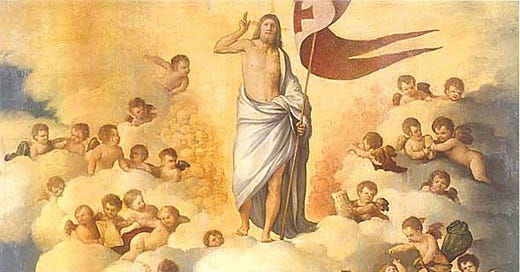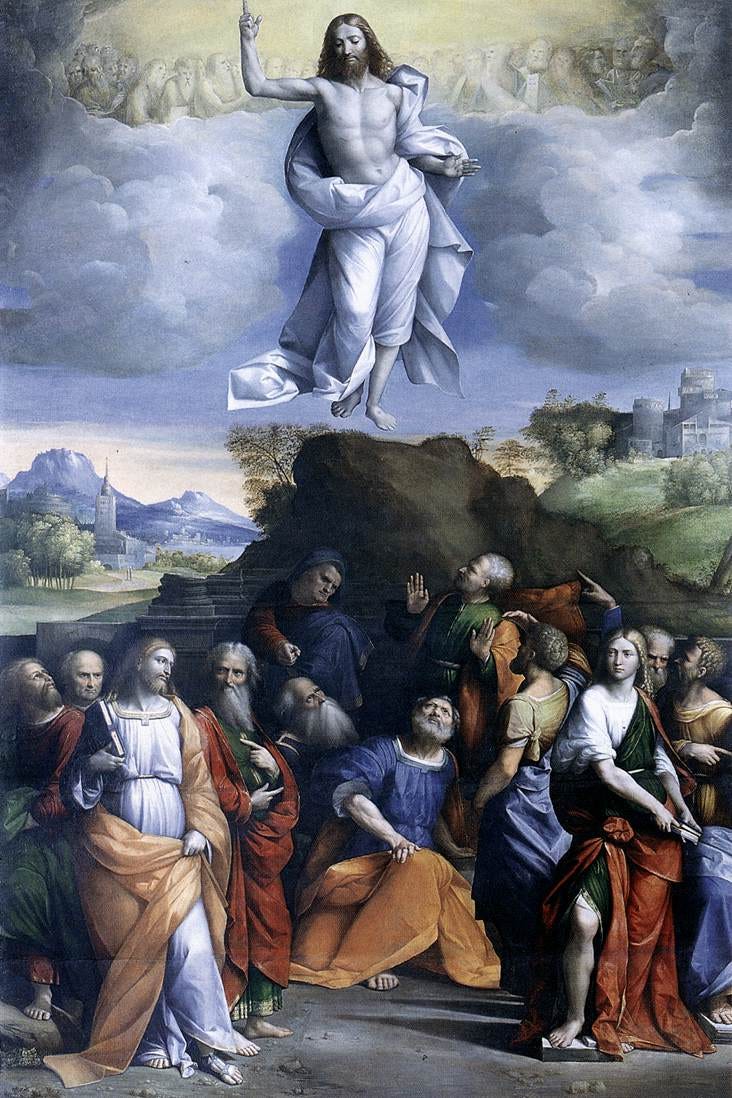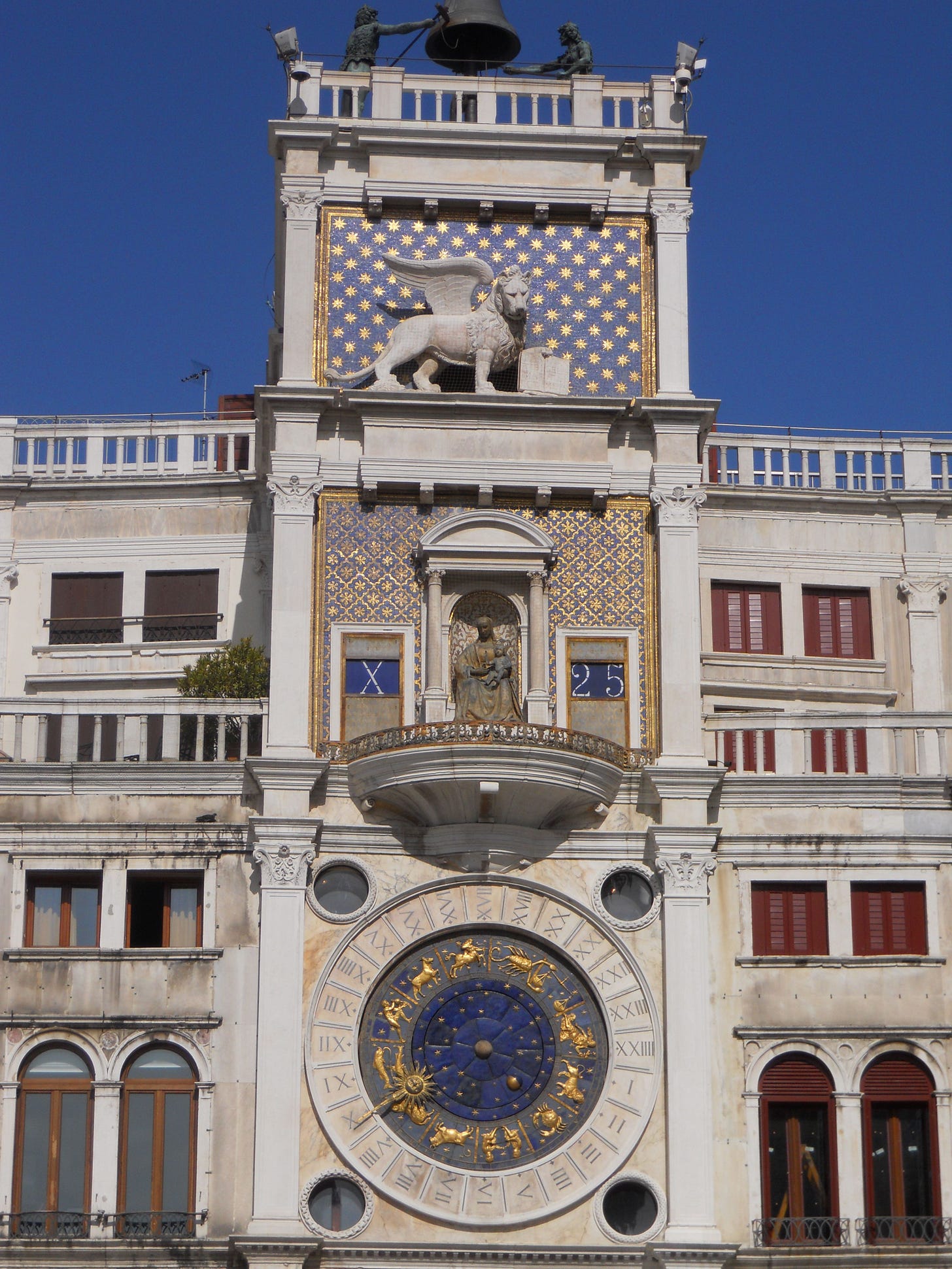And when He had said these things, while they looked on, He was raised up: and a cloud received Him out of their sight. And while they were beholding Him going up to heaven, behold two men stood by them in white garments. Who also said: Ye men of Galilee, why stand you looking up to heaven? This Jesus Who is taken up from you into heaven, shall so come, as you have seen Hm going into heaven. Then they returned to Jerusalem...
He ascended to be glorified with the Father, to sit at the Father's right hand, to rule as King of Kings, to send us the Holy Ghost, and, as Hebrews 1:1-2 says, to be our High Priest Who
is set on the right hand of the throne of majesty in the heavens, A minister of the holies, and of the true tabernacle, which the Lord hath pitched, and not man.
And He ascended to prepare a place for us. St. John recounts in the first 3 verses of the fourteenth chapter of his Gospel that after the Last Supper, Our Lord told His disciples:
Let not your heart be troubled. You believe in God, believe also in Me. In My Father's house there are many mansions. If not, I would have told you: because I go to prepare a place for you. And if I shall go, and prepare a place for you, I will come again, and will take you to Myself; that where I am, you also may be.
As to the place of His Ascension, the Golden Legend, written in A.D. 1275 by Jacobus de Voragine, Archbishop of Genoa, has this to say:
As to the first He ascended from the mount of Olives by Bethany; the which mountain, by another relation, is said the mountain of three lights. For by night on the side of the west it is lighted of the fire that burneth in the Temple, which never is put out ne quenched. On the morning it is light of the orient, for she hath first the rays of the sun before it shineth in the city, and also it hath great abundance of oil that nourisheth the light, and therefore it is said the hill of three lights.
Unto this hill Jesu Christ commanded His disciples that they should go. For on the day of His Ascension he appeared two times, one time to eleven disciples that ate in the hall where they had supped with Him. All the apostles and the disciples and also the women, abode in that part of Jerusalem which is called Mello, in the mountain of Sion, where David had made his palace. And there was the great hall arrayed and ordained for to sup, whereas Jesu Christ commanded that they should make ready for to eat the Paschal Lamb, and in this place the eleven apostles abode, and the other disciples, and the women abode in divers mansions there about.
And when they had eaten in this hall, our Lord appeared to them and reproved them of their incredulity. And when He had eaten with them, and had commanded them that they should go to the Mount of Olivet on the side by Bethany, He appeared again to them, and answered to them of the demands that they made to Him indiscreetly, and with His hands lifted he blessed them; and anon before them He ascended unto heaven.
Of the place of this ascension saith Sulpicius, Bishop of Jerusalem, and it is in the Gloss. For there was edified a church in the place where were made the signs of His ascension. Never sith [afterwards] might be set there any pavement, it could not be laid ne set but anon it issued out, and the stones of the marble sprang into the visages of them that set it. And that is a sign that they be stones on which Christ passed upon, which lie in the powder and dust, and abide for a token and sign certain.
The footprints said to be His are now enclosed in a shrine called the Chapel of the Ascension near the top of the Mount of Olives in Jerusalem. The original building was destroyed by the Persians in A.D. 614, but was rebuilt by Crusaders. The Moslems took control of the building in the 13th century and transformed it into a mosque, walling in the arches, and adding a dome.1
Dom Guéranger elsewhere reflects as to why the Ascension is always mentioned in the Canon of the Mass. Here he expresses similar noteworthy sentiments:
The feast of the Ascension shows us the work of God in its completion. Hence it is that the Church, in her daily offering of the holy sacrifice, thus addresses the eternal Father: the words occur immediately after the consecration, and contain the motives of her confidence in the divine mercy: ‘Wherefore, O Lord, we Thy servants, as also Thy holy people, calling to mind the blessed Passion of Christ Thy Son our Lord, His Resurrection from the dead, and His admirable Ascension into heaven, offer unto Thy most excellent Majesty a pure, holy, and unspotted Host.’
It is not enough for man to hope in the merits of his Redeemer’s Passion, which cleansed him from his sins; it is not enough for him to add to the commemoration of the Passion that of the Resurrection, whereby our Redeemer conquered death; man is not saved, he is not reinstated, except by uniting these two mysteries with a third: the Ascension of the same Jesus who was crucified and rose again.
The Ascension had always been an important Feast to the Venetians: in A.D. 1000, the Doge left on this Feast Day to aid the Dalmatians who were being threatened by the Slavs. This led to Venetian security and became celebrated annually with a blessing of the sea. Then, in A.D. 1177, the Doge helped bring about a peace between Barbarossa and the Papal States. Pope Alexander III was so grateful for the Doge's service that he sent a blessed ring as a sign of the sovereignty that the Doge and his successors will have perpetually over the sea. The blessing of the sea turned into a "marriage with the sea," and since that time, the Doge of Venice would board an ornate, gilded boat (the Bucintoro, or Bucentaur) and be rowed to the lagoon in front of the church of San Nicolo del Lido, accompanied by clergy and government types, and with a procession of other decorated boats following behind. There, the Doge would throw a ring into the waters while saying the words "Desponsamus te mare, in signum veri perpetuique dominii," which mean, "We marry you, oh sea, as a symbol of perpetual dominion." Then the mayor throws a ring into the waters thereby uniting that beautiful city with the sea... (See paintings of the Clock Tower and the voyage of the Doge on the bucintoro, painted by Francesco Guardi.)
In eastern Germany, the Ascension is known as Himmelfahrstag, and is celebrated as "Men's Day." Men get together and do many things, like taking hikes in the woods, playing sports, etc.
Finally, it's common practice to begin a Novena tomorrow (Friday) -- the Novena to the Holy Ghost, in anticipation of the Feast of the Pentecost. This is the time during which the very first novena of the Church Age was made, when Mary and the Apostles prayed from Christ's Ascension to the Pentecost, a period of nine days (Acts 1-2).
A devotion offered in honour of the crowning of our Most Blessed Mother as Sovereign Queen of Heaven and Earth, traditionally during the month of May, Mary’s month. It is prayed specifically for:
• the Holy Catholic Church,
• the propagation of the Faith,
• peace among Christian peoples, and
• the extirpation of heresy.
ALL praise and thanksgiving be to the ever Blessed Trinity, Who hath shown unto us Mary, ever Virgin, clothed with the sun, with the moon beneath her feet, and on her head a mystic crown of twelve stars.
R/. Forever and ever. Amen.
V/. Let us offer praise and give thanks to God the Father Who elected her for His daughter.
R/. Amen.
Our Father …
V/. Praise be to God the Father, Who predestined her to be the Mother of His Son.
R/. Amen.
Hail Mary …
V/. Praise be God the Father, Who preserved her from all stain in her conception.
R/. Amen.
Hail Mary …
V/. Praise be God the Father, Who adorned her at her birth with His choicest gifts.
R/. Amen.
Hail Mary …
V/. Praise be God the Father, Who gave her Saint Joseph for her pure spouse and companion.
R/. Amen.
Hail Mary … Glory Be …
V/. Let us praise and give thanks to God the Son, Who chose her for His Mother.
R/. Amen.
Our Father …
V/. Praise be God the Son, Who became incarnate in her womb, and abode there nine months.
R/. Amen.
Hail Mary …
V/. Praise be God the Son, Who was born of her and was nourished at her breast.
R/. Amen.
Hail Mary …
V/. Praise be God the Son, Who in His childhood willed that Mary should teach Him.
R/. Amen.
Hail Mary …
V/. Praise be God the Son, Who revealed to her the mysteries of the Redemption of the world.
R/. Amen.
Hail Mary … Glory Be …
V/. Let us praise and give thanks to God the Holy Ghost, Who made her His spouse.
R/. Amen.
Our Father …
V/. Praise be God the Holy Ghost, Who revealed to her first His Name of Holy Ghost.
R/. Amen.
Hail Mary …
V/. Praise be God the Holy Ghost, through Whose operation she became at once Virgin and Mother.
R/. Amen.
Hail Mary …
V/. Praise be God the Holy Ghost, through Whom she became the living temple of the Most High Trinity.
R/. Amen.
Hail Mary …
V/. Praise be God the Holy Ghost, by Whom she was exalted in heaven high above all creatures.
R/. Amen.
Hail Mary … Glory Be …
For the Holy Catholic Church, for the propagation of the faith, for peace among Christian princes and for the uprooting of heresies, let us say:
Hail, Holy Queen …
(Pre-1968 Indulgence of 3 years.)
https://www.fisheaters.com/customseastertide6.html







